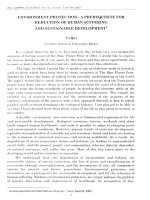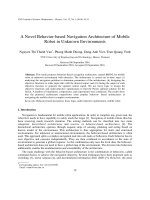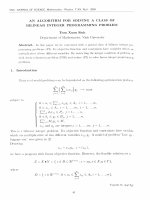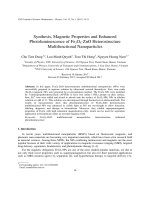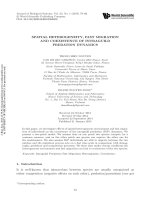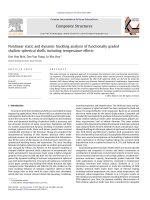DSpace at VNU: Angle - Resolved Laser - Ray Photoelectron Spectroscopy of Simple Metals
Bạn đang xem bản rút gọn của tài liệu. Xem và tải ngay bản đầy đủ của tài liệu tại đây (3.33 MB, 6 trang )
VNU, J O U R N A L O F SCIENCE, Nat . Sci , t XV, n " 2 - 1999
A N G L E - R ESO LVED LASER - RAY PH O TO ELECTRO N
S P E C T R O S C O P Y OF SIM PLE METALS
N g u y en Van H u n g
FiiCiihy of Physics, College of Natural Sciences - V NU
I. INTRODUCTION
Photoelectron nu'asun'd in spectrometer have energy and momentum which are
coniK'crod to th(' onos inside the crystal. T hat is why photoelectron spectra provide
Iiiforniation about olectroilic structure of solid states [1
This work is the next, step
of OUI previous one [2] in whicli a theory of Angle - resolved Laser - ray Photoelectron
Spec tioscorjN- (LPS) has been tiovelopecl. According to this theory the intensity of LPS
sp e rtia is
by:
l ụ . f. q.
ĨĨ.E,c,)dErìn,, ~ I r/3p(T ,_,; +
- E,)Ố{E - E, - nhw), (1)
here the liuoar contribution:
2 tt
h
1
/2)Ơ2
/ /
h J : y f„ (7Ỉ.V. - E , -
w h ) ■■■Un IV /„ )
- E, - 2 huj') • ■• ( % , - E, - Nhuj)
(' I I V ' I } ! ,) u : , I
f:
' i / ' ) . . . (/;, I H" 1/^)
Ef!^ - E, - 2huj){Ef> - E, - Ah^) ■■■{Ef;^ - E, - 2Nhuj)
n =
(2 )
(3)
. N ^ 1.
I li(> tiiiK tioii
— E,) indicates that photooloctrons have boon transmittod from
the
with ciicigy E, tlirougli the Fermi levol FfS I i) and I / ) descTÌbo plectronir
states: ^ '.r. r / a i c fioquenry. polarisation vector and momeutiim of photon; bl, 4),Ti. are
ha.sic \c< tor of K'ciproral vpc to! g, the height of potential barrier and surface - normal of
( I \ s t a l ; E . c l are kinetic ('Iiergy and moving direction of photoeiectron to spectrometer,
iosp(-cri\(>ly. U’. w aio powf’rful radiations of laser ray. Electron is emitted to the final
statí' 111 a Piirigy iiitorval (iE and a space angle dũp. ỉìa is fhp angle of acceptance. If
matiix ('IciiK'nts are ronsideiecl to be coustant, the intensity of LPS spectra is characterized
by Plan(> Densitv of States (PDOS)
e,.k„) = Y ^ ị
BZ
dH- 6(6 - E{k, í.))ổ(ẽ;.Ẳ- - ko),
(4)
Nguyen Van Hung
30
whoro ly is band iiuiex. k is wav(* voctor and A'o is distance of ( onsidoK'd ciOoS - section to
th(' center of Brillouin zone (BZ).
Our purpose ill this work is to calculato matrix elements ill (2) and (3), that nu'ans.
the iỉit(‘iisity (1) for siinpl(‘ metals and through tliat to ovaluatP the aiifth'-n^solvod LPS.
The numerical c-alrulation is carried out for Beryllium (Bo), a typical simple metal.
II. INTENSITY OF LPS SPECTRA OF
s im p l e : m e t a l s
The most important simple metals with configurations of the outer electronic shell
are presented in Tab. 1. The positive ions in these siinpk' iiK'tals are small. The conduetin^ electrons which are not strongly influenced by positive ions can move near froolv.
Thereforo. these near free electrons can 1)0 (lpscrih(^d by Orthogonal Plane Wave (OPW )
Monovalent
Li
Na
K
Rb
Cs
Alkalim etals
2s
3s
4s
5s
6s
Bivalent
Be
Mg
Ca
Sr
Zn
Cd
m etals
2s'
3s^
4 s2
5s2
4s2
5s^
T hreevalent
A1
Ga
In
m etals
3s^3p
4s^4p
5s^5p
Tab. 1. Most important siinplo ni(' tals
with ( oiifiguiatioiis of outer ('Ifctionic shell in Iiputial atoms
~ | i/-'"'’" ' ) =
/■
<
I V’c K r r
I
I
;,y =
,N
+
i.
■) I
whoH' tho core - fiinriioii is givi'ii by
()
and pseiuh'-fuuctioiis have th r form
(7)
I
ịh
111 th(\s(' íuiictiơus
is \va\’0 \'(H’tor <‘01(' - stat(‘ and ÍÌ is Iioniializiii^ \'oluin<‘. Th(‘ 0 P \ \
(5) (lescriho th(' following electronic states
- Initial state, if j — 1(^1 = Ư.(J\ — g).
- Iiitriniediate states, if j — 2, 3, • ■■, A\
- Final state, if j — N + I whicli is r r d u m l to one OPW, it means that
i . K i ) =1
P v t i - i i , = 9.v*,.
(81
Angle - Resolved Laser-^ray PhotoeAectron Spectroscopy o f Simple Metals
31
Mu' function (G) is nonualiz(‘d acTonling to thr numl}rr Nc of basic rolls at R
and cacli ( ('11 has Na atoms at ('//. In the ahov(^ expiossions the inoniontuni conversation
A7 = k ÍOI transition from initial statr-to intprmodiato and filial ono is satisfied.
1 li(' (01 ('-iunctioii VV: ^ippf'ais o n l y in a c o m b i n a t i o n whic h is c a lc ul a te d as follows
'■
/7
“ IỈ —
+■■■■+■
~ ĨỈ ~ <Ĩị )
(9)
Fioiu thí' oiilu)o(jualizatiou of O PW (5)
^,^,o/nr I
p_^y,^y,ự,JP)ự>:{P')S{P - F ' ) | ,
I
( 10)
^
ĩỉfy
[
in uur ca.s(‘ \V(' liToivod
F' ^ 1
^ g')S(g ~ (f ).
(
11)
In tlie ('alculation \V(' ha\'e used the expressions of stnicturo factor
S{q-q') = - ^ y
No ^
I
( 12)
Fouihm tiaiisfonii of atomic fuiictioii
ự>,.w =
'Vr.
(13)
and íli(' r('latioii
y ,A ĩ-ỉ)R ^
/
...
‘7 'I n
(14)
f’oi siniplr iiH'tals íh(' ort liogonalizin^ coiiiponiMit in O FW is small. W(‘ can nogloct
ihc second part in tli(' I inht of oqiiation(ll). that moans F'^ ^ 1. Mơie‘0V('i'. fm ' oleríron
(kn's I!0I ahsoiỉ) ('1(TÍloniai^iH'tic waves. T hon’foio wr* locoivod
r
I/)(/ H 51 X] I
I c
I
I ■(15)
Usiui> thí' abo\'í' I(\sults. we calculated thr inatiix elements for orio transition and
('
I
I / )
- 'f.
~
- q + f / ) S { g - (fp - q).
(16)
9
After lietailing c alculation of matrix elements (2) and (3) we received the intensity
ot au*2,le - irsolv(*(l LPS spectra ( 1 ) for simple metals in the following form
I ( w .ẽ ; ĩ},b ,. 0 :E,cĩl)dEdíìp ~ Ị d^k ^
{ I M{ k , ư j , ẽ . Ru P j ) 1^
+ I M \ k , i/^,2w, p ;) 1'“^ ]9{E e ~ E{k, v))ỗ{E - E{k% u) ~ nfìuj),
(17)
Nguyen Van Hung
32
latrix elements for the linear contributions are given
where the matrix
N
M
Y.C g{k,
g
=
l^ )
ư
E{k,
) n
j=2
~
(18)
j ^ \ ) í P a { k
9 j
+
i ) ______
) - E{k, v) - u - ì )fì^ '
linear ccontributions
o n tn OUT,ions
and for the unlinear
N
M ' = Y^Cg>(K i ^ > a iP { ) n
9
.7=2
2-'- P j ) S i P - 9] - Õ)
’
(19)
Cg'^^^{k,iyj +-í)ự’a{ĩ' + ểj +l)
'
^j +ỉ
E{k. Uj+i) - E{k% u) - 2(j - l)f^^
If the number of absorbed photons is definP(i wo can calculate the inteiisit>- of
angle-resolved LPS spectra of simple metals according to equations (17-19). The linear
contribution to LPS is dependent on polarisation of laser ray, but the unlinear onr is
independent on it.
III. NUMERICAL RESULTS OF PDOS FOR Be
It was shown that for evaluation of LPS spectra we can consider the matrix eleiiK'nts
to be constant and the intensity of angle-resolved LPS spectra is proportional and the to
the PD OS [1-3]. Beryllium (Be) is a typical simple metal, that is wh>’ it is H(4('ctecl for
calculation of PDOS. We investigate the valence band of Bf‘ and for laser ray Iih^' >
lOOOeF, In this case thp, intensity of angle- resolved LPS spectra of Be is given 1)V
,
- A’d)
Bp has hexagonal closed packing (hep) stnicture. Its BZ is shown in Fig. L. riic
energy band structure of Be has been calculated hefore [4,5]. Using those riiorp,i('s \V('
calculated the contributions of a cross- section of BZ which is pei pi'iulictilai to tho outp,oiii”
direction Cs of photoelectron. Figs. 2 and 3 show PDOS for tlie d i m tioiis
(contribution from FAHK plane of Fig. 1) and C s //r K (ronti ibution from r ALM of
F ig.l), respectively. They contain the contributions of the 1st, the 2nd and the 3rd band.
Therefore, they contain the detailing information of elertioiiir stiurtu io of tlio coiisidpK'd
direction. We can see in Figs. 2 and 3 that from BZ ceiitor to the ('lU'igy of 0.4a.u. tli(>
electron behaves as free, that is why we receive the PDOS of free electron. , They aio
about constant and isotropv. But at higher energies tliP PDOS are aiiisoti'opy and 110
more constant. Therefore, the PDOS can characterize the aiiglo-iosolved LPS of Bo.
Aĩigle - Resolved Lnser-rny Photoelectron Spectroscopy o f Simple M e ta ls
Fi(]. Ỉ. BZ of Be with hep structure
Fig. 2. PDOS of Bo for F M direction
IV. CONCLUSIONS
T..
* . 1. : __________ 1 .
i .1
_
1
I T
r
33
N g u yen Van Hung
34
E l e c t r o n s in th is cast' b e h a v e as IK'H!
OIK'S,
that is \vli\' tlu'ii statf's ai(' (I'SCIilx'd In'
O P W . T h ( ' m a t r i x (‘lin iun its
Í la iis irio u s th iu n .i;h iu ti'i iiK ’d ia t c s ta tis au
confribntioiis.
c D n r a i u t h í ' f u i i T i i i ) u t i o u > i OÍ a í o i u i t ’ t u i u ’t i o n s . s T u u t u K
iactoi
and
icH'ific ii’iits ut Blocli tunctioiis tor (.litii'i('lit
bauds and KH'iprocal N'l' tois. rii('
of })liutơ(*l(‘Ctioii is coataiui'd in Iiioiui'iitmu p. These \alu('s ai(' iinpoitaut for
a u a h 's is ot ('Ip c tro n ic sTnu tu ro o f t h e c iw s ta l. T h i ' liiK'ai CU11Ĩ 1
Tt) L P S i.'' tl('p(‘iu l('n t
on polarisation of laser ia\'. but tho unlinoar OHO is in(l('poiHli‘iit on it. PDOS of B<' tov
c litfe ie iii o n to o iu ft direc tio n s o f p h o to o lo c tio n hav(' h o v u ( a k * u la r (‘(l.
P D O S o f B e fo r (liffpKMit out»,oiui*, ( l ii í T ĩ i o n s o f p h o to ('l(’c r io u lia v(' hoiui ( a l( u la te d .
Tlu'\' show tlio iK'ar fi(H* i)(‘havior of i'k'c-troiis ill simple iiK'tals and Tlii’ii cK'ai aiiisoĩro])>'
iu (liiftn c n r d iio c tio n s . T l i ( n r f o n \ th e y c h a r a c ti'r iz i' t h ( ‘ aii;*li'-!<'S(jl\-(‘(l L P S i)io \i(lin < ;
(lo ta iliu i^ iii f o n i i a t i o n ot ('li'i t io iiic s t n K ĩ i i n ' o f B('.
A c k i i o w l e d g m e u t T lli^ w o r k M'as c a i'iii’d OIU u itili'i ĩ l u ’ p la n OỈ tlu ' F i i u l a i i i e n t a l
R ('S('ar( li P r t) ” r a ia .\o . 4 . 3 . l A .
REFERENCES
[1.’ N. V. Huaj;.
. l u n i f i dl o f Pl i Ị Ị sỉ ỉ s.
N,j3( 1981)().
[2.' X. \ ' . Fluij^. J ot i i ' . Sr i ( - f i c r . Vol.8. .\'o l i lí)97)2õ.
'li.ị
P . R('iiii(Mt a n d
X . \ ". H u m ; .
4.1 M- T a u t . P i n / S .
Sfuf. SnL
E.fỊ>.
iiih .
/^////s/i,s.2 G ( H J 7 S ) 1 0 1 .
(i))54(li»72; 119.
5.1 P. R i'iiu iT t a n d X . V . H u u ^ .
Erf)-
Tcch.
Fliij-S. 2 9 ( 1 9 8 1 )
1.
T A P CHI KH O A HOC ĐHQGHN, KH TN . t . x v , n‘^2 - 1999
PHO QUAXC; ĐIẺX T l ” DUNG LASKH PIỈỤ THUỌC GOC' C TA KIM LOAI nO N CIA
N g u y ễ n V a n H ilu g
K ìioỉt
\V ỉf
l ý . Đ i ì i ỈÌỌC KÌ I UỈ Ì h ọ c T ĩ ỉ
hài Iià\' cirừiii; <1()
c iia k iu i loai (lư u ^iiin ( ! ã (h n rc
(liỗ ii !)ÍU 1^ MJiii; p lia u ;; t n r c ;;iao
CiU' t ! ạ ii^ t liái I Iiy í '11 t íiili \ ìi plii
tnrii^
Đ I Ỉ Q C Ỉ Ỉliỉ \ o i
các Ịìluì qiiaiiiJ, (liíMi tư tlùii.i; ỉasí'1 (Í.Ỉ^Sì ì>liii ílnux UUI
tlá iili ^iá. C iic Uaii.u, Itan ;^ lliiii c u a
n r (Iưtrc l)i(Mỉ
i O P W ’ ). C i \ ( \'(’U u> Iiia í r ạ n (líii \'ứ i CÌU (iìii\'('H (lịch f|u;t
I I iv r i ỉ C’liiui;; 1)ÍH> clnVa Iiliừ n ^ ílạ i h rự n ^ í|u a ii t rụ iii; (líì<
c h o CHU ĩ i i ' u ' (l i í Mi t ư c i ì a \ ‘à t
t l u ' Iiliir h à m
n , ^ u \ ' ( ’n í i r . lif' > ó c a n
Í MK
\ ' à ( ỈU- i l u M i ; ;
số \'ỈIU” Iiãii^ lưựii”,- Pli'au tính số luat (lu íiaii.i; Uỉai Ị)lian^ (PD OSi (lã tlnri liicii (lio
Bí'. C h rm > ; (là t ln' liir ii cííc (lãc I íiil! í ư hỉUi CIIÍI (lic ỉi tư t n m ; ; k i m lo a i ( h n i ^ là ii \'à klioii;^
(ta n i; hux>u^ k lù Ciuauj;
tư
ra th i'o các liư ứ n ^ k liiu n h a u . D o (ỉó I ^ l ^ o s CUII^ ( a]>
các rhou^ tiu chi lirt vV* cati tnic' (liọii tư cua B(' lilìạn tư các pho LPS I)lỉu tlnnK- oỏ(


